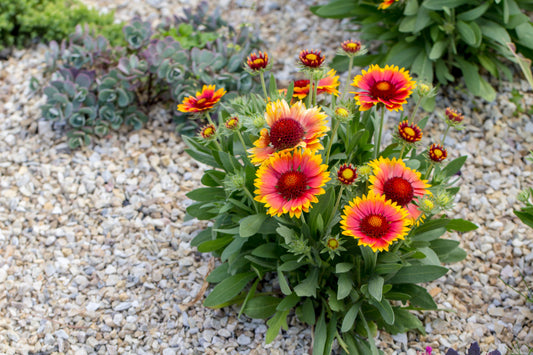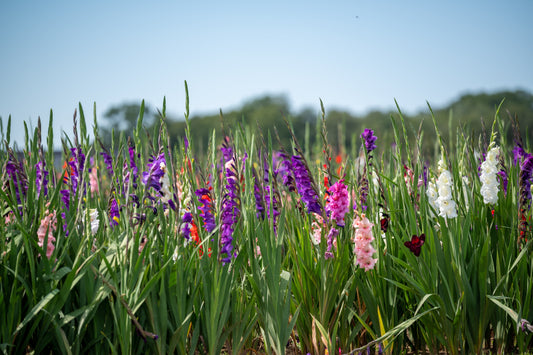Clematis Planting & Growing Guide
Planting Guide Information
-
Crown at soil linePlanting Depth
-
Species dependent.Planting Proximity
-
SpringPlanting Season
-
One of the best long-lived perennial vine species.Plant Benefits
-
ModerateWater Quantity
-
Late Spring through SummerBloom Season
-
Full Sun to Partial SunSunlight Quantity
-
Zones 4-8Hardiness Zones
Additional Growing Information
Where to Plant
While some Clematis varieties grow rampantly from the ground, climbing strong arbors, trellises, and walls, others are suitable for container growing. Regardless of whether you choose a shorter, non-climbing type or a taller climbing variety, these lush beauties prefer at least 6 hours per day of sunlight and rich, neutral soil with good drainage. Certain species are adapted to partial shade, and all benefit from some afternoon shade in warmer climates.
When to Plant
Plant Clematis in the spring or fall, depending on the variety and climate conditions. Many advise planting in the spring to give it time to become well-established before winter hits. There are many different types of Clematis with varying bloom times and planting preferences, so you're bound to find the right one for your garden! With the right selection, you can experience gorgeous flowers from early spring until fall.
How to Plant
- For outdoor landscape planting, find a spot with neutral, well-drained soil where your plant will receive at least 6 hours of sunlight per day. Clematis should be spaced 24–36" apart, with aggressive growers requiring more space than compact bush types. Dig a hole large enough to bury the pre-potted plant up to the first set of leaves. Be careful not to break the fragile roots and shoots when moving your Clematis from the pot it arrived in to the new hole. Gently pat the soil surrounding the plant and add 4" of mulch around the base or use low-growing perennials to keep the roots cool. After planting, provide some type of support for your Clematis to climb.
- For container planting, choose a large container with drainage holes and the capacity to hold enough soil to protect the roots in the winter and during scorching summer days. Resin plastic is an excellent option for container material, as terra cotta or ceramic planters can crack in the winter. Find a sunny spot and fill your container with neutral, well-draining soil. Dig a hole large enough to bury the pre-potted plant up to the first set of leaves. Be careful not to break the fragile roots and shoots when moving your Clematis from the pot it arrived in to the new hole. Gently pat the soil surrounding the plant's base stem. After planting, install some support for the vine to climb.
- Water thoroughly, giving your Clematis a long, deep drink of water after planting.
How to Grow
- Water regularly, preferably in the morning, through the growing season, whenever the soil appears dry.
- Fertilize every 4 to 6 weeks with 10-10-10 fertilizer, or dress the base with compost to give your plant the nutrients it needs to produce ample blooms.
- Prune the stems down to the lowest healthy buds early in the first spring after planting, then continue pruning to control the size and encourage more blooms. When to prune depends on the variety, so be sure to note the pruning recommendation for your particular Clematis.
- Remove any dead or damaged stems regularly throughout the growing season.
Clematis Tips & Tricks
- Expect bloom times to range from early spring to autumn, depending on the variety. Some species will even flower twice in a single growing season!
- Ensure your chosen container has adequate drainage holes to keep the roots from becoming waterlogged.
- Be mindful not to overwater your Clematis, as the shaded roots tend to hold water for a more extended period.
- Rejuvenate older Clematis plants by cutting them back harshly after the first round of blooms.
From the Family
-
 30% OffPreorder
30% OffPreorderClematis - Nelly Moser
1 Plant in a Quart PotRegular price $34.97Sale price $34.97 Regular priceUnit price per$49.9530% OffPreorder -
 30% OffPreorder
30% OffPreorderClematis - Piilu
1 Plant in a Quart PotRegular price $34.97Sale price $34.97 Regular priceUnit price per$49.9530% OffPreorder -
 30% OffPreorder
30% OffPreorderClematis - Mrs. N Thompson
1 Plant in a Quart PotRegular price $34.97Sale price $34.97 Regular priceUnit price per$49.9530% OffPreorder -
 30% OffPreorder
30% OffPreorderClematis - Henryi
1 Plant in a Quart PotRegular price $34.97Sale price $34.97 Regular priceUnit price per$49.9530% OffPreorder -
 30% OffPreorder
30% OffPreorderClematis - Taiga
1 Plant in a Quart PotRegular price $34.97Sale price $34.97 Regular priceUnit price per$49.9530% OffPreorder








